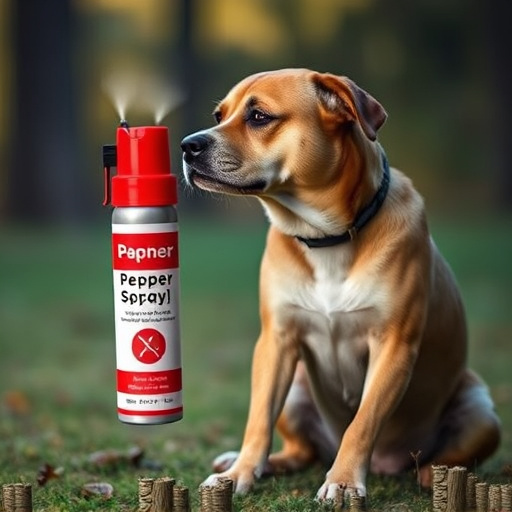Pepper spray (oleoresin capsicum, OC) is a non-lethal self-defense tool for dogs with aggressive behaviors, legal in 47 U.S. states but with varying regulations. Responsible usage requires understanding local laws and training from certified courses to prevent harm to dogs and handlers. While pepper spray is common, positive reinforcement, desensitization, counter-conditioning, and exercise are alternative solutions that address the root cause of aggression.
“Unleashing control over aggressive canine behavior: Exploring Pepper Spray as a Tool. This comprehensive guide delves into the world of pepper spray for dogs, offering insights on its effectiveness as a safety measure. We examine what pepper spray is and how it works to deter aggressive attacks. Understanding legal considerations, including states where carrying pepper spray for dogs is permitted, ensures responsible usage. From training guidelines to exploring alternatives, this article equips owners with knowledge to navigate aggressive dog interactions safely.”
- Understanding Pepper Spray for Dogs: What It Is and How It Works
- Legal Considerations: States Where You Can Legally Carry Pepper Spray for Dogs
- Training and Safety Guidelines for Using Pepper Spray on Aggressive Dogs
- Alternatives to Pepper Spray: Training, Behavior Modification, and Other Options
Understanding Pepper Spray for Dogs: What It Is and How It Works
Pepper spray, also known as oleoresin capsicum (OC), is a non-lethal self-defense agent that has been in use for years. In the context of dogs, particularly aggressive ones, pepper spray is often considered as a tool to deter and control unwanted behaviors. It’s important to understand that pepper spray for dogs is specifically formulated to cause temporary discomfort without causing serious harm. When used appropriately, it can give dog owners and handlers time to safely move away from an aggressive dog.
The active ingredient in pepper spray, capsaicin, irritates the eyes, nose, and throat of a dog, temporarily disrupting their balance and sensory perception. This reaction allows the person to create distance between themselves and the dog. In many U.S. states where it’s legal to carry pepper spray for self-defense, including dogs, proper usage and training are paramount. It’s crucial to familiarize yourself with local laws regarding the legal carry of pepper spray and ensure you have a valid reason for doing so, such as dealing with known aggressive canines in your area.
Legal Considerations: States Where You Can Legally Carry Pepper Spray for Dogs
When considering pepper spray as a deterrent for aggressive dogs, it’s crucial to understand the legal landscape surrounding its use and possession. The legality of carrying pepper spray varies significantly from state to state, with some allowing its use for personal protection against animals while others have strict restrictions or outright ban it.
In the United States, 47 states permit the legal carry of pepper spray for self-defense purposes, including against potentially aggressive dogs. However, specific regulations regarding dog-specific deterrents vary. Some states explicitly allow the use of pepper spray for dog control while others may have loopholes or exceptions in their laws, making it essential to check local legislation before purchasing and carrying such a device.
Training and Safety Guidelines for Using Pepper Spray on Aggressive Dogs
When considering pepper spray as a deterrent for aggressive dogs, it’s paramount to approach its use responsibly and safely. Training is key; professionals recommend enrolling in certified dog handling courses to learn safe and effective techniques. Understanding your state’s legalities regarding the legal carry of pepper spray for dogs is crucial before purchase and deployment. Each state has unique regulations, so consult local laws to ensure compliance.
Safety guidelines should be strictly followed to prevent harm to both the dog and the handler. This includes wearing protective gear, keeping a safe distance, and having a clear escape route. Regular practice in controlled settings helps in building confidence and mastering the spray’s application without causing undue stress or injury to the animal during training.
Alternatives to Pepper Spray: Training, Behavior Modification, and Other Options
While pepper spray is a popular option for deterring aggressive dog behavior, it’s not the only solution. In some states where carrying pepper spray for self-defense against dogs is legal, individuals often seek alternatives to reduce reliance on chemical agents. Training plays a crucial role; positive reinforcement can teach a dog appropriate behavior and responses to triggers, ultimately preventing aggressive outbursts.
Behavior modification techniques, such as desensitization and counter-conditioning, are also effective. This involves gradually exposing the dog to the stimulus that provokes aggression in a controlled environment, helping them associate it with positive outcomes rather than fear or aggression. Additionally, providing mental stimulation through exercise and interactive toys can alleviate boredom and reduce the likelihood of aggressive behavior.
When considering the use of pepper spray for aggressive dogs, understanding both its effectiveness and legal boundaries in your state is crucial. As discussed, pepper spray can be a viable option for deterring canine aggression during emergency situations. However, it’s important to remember that it’s not always the first line of defense; alternatives like training and behavior modification should be explored first. Moreover, being aware of your area’s regulations regarding the legal carry of pepper spray for dogs is essential to ensure compliance and promote public safety. By combining knowledge, practice, and adherence to local laws, dog owners can navigate this tool with responsibility and care.
